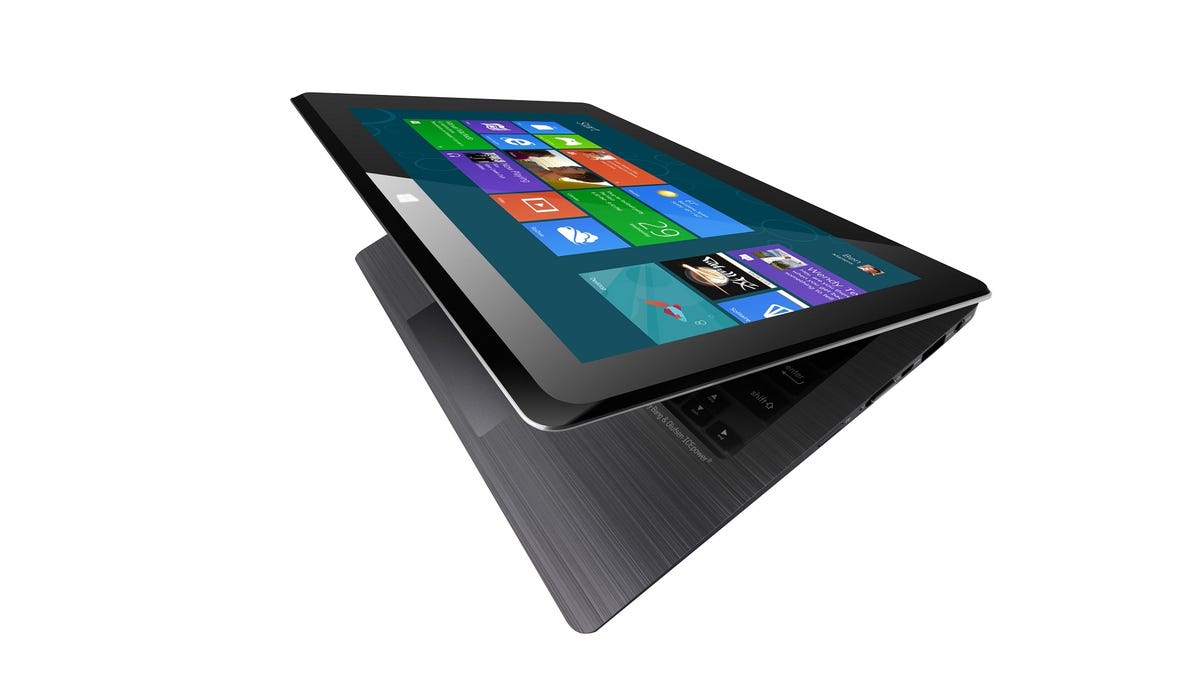Meet the Asus menagerie of Windows 8 hybrids, ultrabooks and tablets from IFA
The variety of intriguing and sometimes wild Windows 8 designs from Asus comprise an aggressive portfolio of tablets and laptops, including the dual-screened Taichi and several detachable tablet/keyboard hybrids. Here's the complete rundown from Berlin.

Think you've got a handle on what Windows 8 means for laptops and tablets? Based on Asus' announcement of a bevy of new products at IFA, you're not even close.
Asus has been a champion of aggressive design ideas for years, and to the company's credit, a lot of these products seem like clever ways to explore the touch potential of Windows 8. There are no fewer than three detachable tablet-cum-hybrid laptop products, two touch-screen laptops -- one of which has a two-sided screen -- and a large, standard but very stylish ultrathin 15-incher. Let's take a walk through the magical Windows 8 zoo, shall we?
Asus Taichi: Perhaps the most aggressive concept of the bunch, the Taichi is an ultrabook with a "double-sided display," according to Asus. Open the lid, and you have a standard ultrabook. Close the lid, and the back of the Taichi becomes a "multitouch tablet with stylus support." Even weirder, Asus claims that both screens "can operate independently and simultaneously, which means the Taichi can be shared with two users for a host of innovative new applications." At this moment, the only killer app I can think of is a mean game of Battleship. The Taichi should be roughly the same dimensions as a Zenbook, with unspecified third-gen Intel Core i-series ultrabook processors and SSD storage. Details are otherwise slim on the Taichi, but it looks like an interesting competitor to the IdeaPad Yoga...with a similarly health-influenced type of name.
Transformer Book: Despite the name, this isn't an Android tablet like previous Transformers: it's a full Intel Core i7 ultrabook with a detachable top screen that becomes a tablet. Storage options include an SSD or standard hard drive. Asus touts SonicMaster technology in the Transformer Book, delivering higher-end audio via its internal speakers. No further details like price or other specs are available, but this looks like a larger-screened ultrabook variant on the tablet-with-keyboard hybrid that's turning into a trend in the 11-inch space.
Vivo Tab: Meanwhile, the Asus Vivo is exactly that type of 11-inch Windows 8 tablet-with-optional-keyboard I was talking about above. Paired with an next-gen Atom processor, the Vivo has an 11.6-inch 1,366x768 Super IPS+ display covered with Corning Fit Glass, while the detachable keyboard dock with touch pad adds a secondary battery and USB port. The screen has built-in Wacom digitizer technology for stylus use. Internal specs include 2GB of RAM and a 64GB SSD. The Vivo Tab's 8.7 millimeters thin, weighs 675 grams, and has an 8-megapixel rear camera with flash, a 2-megapixel front camera, and an NFC sensor. This is similar to other Atom Windows 8 hybrids we've seen recently like the HP Envy X2, Lenovo ThinkPad Tablet 2, and Samsung Series 5 Slate.
Vivo Tab RT: The Windows RT version of the Asus Vivo bears a very similar look, but weighs a little less (520 grams) and is thinner (8.3 mm). Its screen is also smaller (10.1 inches, 1,366x768-pixel resolution), and lacks Wacom stylus support. It has an Nvidia Tegra 3 quad-core processor and 12-core GPU, along with 2GB of RAM and 32GB eMMC storage. The detachable keyboard works in the same way as the full Windows 8 Vivo Tab, and the Vivo Tab RT has the same cameras and NFC compatibility as its slightly larger cousin.
Asus Zenbook Prime UX21A Touch: This Windows 8 update to the Zenbook line has similar specs and features to the existing and ever-growing Zenbook Prime series of ultrabooks, with the addition of a multi-touch capacitive display. The screen boasts ten-point touch and a full HD Super IPS+ screen with viewing angles up to 178 degrees, along with the expected third-gen Intel Core processors and up to 256GB of SSD storage. Asus promises a battery standby time of up to two weeks.
Asus Zenbook U500VZ: Last but certainly not least in terms of sheer size, the Asus Zenbook U500VZ is an ultrathin 15-inch laptop powerhouse that's more akin to the category/class of a Retina Display MacBook Pro than any ultrabook. The spun-finish aluminum body recalls the Zenbook series, but the internals are strictly high-end laptop: a quad-core Intel Core i7 CPU, Nvidia GeForce GT650M graphics. The 15-inch IPS display doesn't have touch, but it has a full 1,920x1,080-pixel resolution and antiglare finish. The full keyboard/number pad has automatic backlighting. There's an option for dual SSD drives with capacity up to 512GB (it's unclear whether that means a total storage of 512GB, or dual 512GB SSDs), or you can pick a more affordable 500GB hard drive with a 128GB second SSD drive.
Pricing and availability haven't been announced yet, but stay tuned for more details. Despite the wide range of products, it looks like Asus is fielding a lot of very compelling concepts that could actually be useful...even the Taichi.

